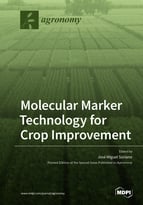Molecular Marker Technology for Crop Improvement
A special issue of Agronomy (ISSN 2073-4395). This special issue belongs to the section "Crop Breeding and Genetics".
Deadline for manuscript submissions: closed (31 July 2020) | Viewed by 64502
Special Issue Editor
Interests: plant breeding; genomics; marker-assisted selection; gene discovery
Special Issues, Collections and Topics in MDPI journals
Special Issue Information
Dear Colleagues,
Since the 1980s, agriculture and plant breeding have changed with the development of molecular marker technology. In recent decades, different types of molecular markers have been used for different purposes: mapping, marker-assisted selection, characterization of genetic resources, etc. These have produced effective genotyping but the results have been costly and time-consuming, due to the small number of markers that could be tested simultaneously. Recent advances in molecular marker technologies such as the development of high-throughput genotyping platforms, genotyping by sequencing, and the release of the genome sequence of major crop plants open new possibilities for advancing crop improvement.
This Special Issue will focus on recent advances in “Molecular Marker Technology for Crop Improvement”. We welcome novel research and reviews covering all related topics including new marker technologies, their development and application in crop breeding: linkage mapping, GWAS, marker-assisted selection, fine mapping, genomic selection. This issue will present a good picture of the state-of-the-art and potential future of marker-based breeding approaches.
Dr. Jose Miguel Soriano
Guest Editor
Manuscript Submission Information
Manuscripts should be submitted online at www.mdpi.com by registering and logging in to this website. Once you are registered, click here to go to the submission form. Manuscripts can be submitted until the deadline. All submissions that pass pre-check are peer-reviewed. Accepted papers will be published continuously in the journal (as soon as accepted) and will be listed together on the special issue website. Research articles, review articles as well as short communications are invited. For planned papers, a title and short abstract (about 100 words) can be sent to the Editorial Office for announcement on this website.
Submitted manuscripts should not have been published previously, nor be under consideration for publication elsewhere (except conference proceedings papers). All manuscripts are thoroughly refereed through a single-blind peer-review process. A guide for authors and other relevant information for submission of manuscripts is available on the Instructions for Authors page. Agronomy is an international peer-reviewed open access monthly journal published by MDPI.
Please visit the Instructions for Authors page before submitting a manuscript. The Article Processing Charge (APC) for publication in this open access journal is 2600 CHF (Swiss Francs). Submitted papers should be well formatted and use good English. Authors may use MDPI's English editing service prior to publication or during author revisions.
Keywords
- plant breeding
- marker development
- genetic mapping
- marker assisted selection
- genomic selection






